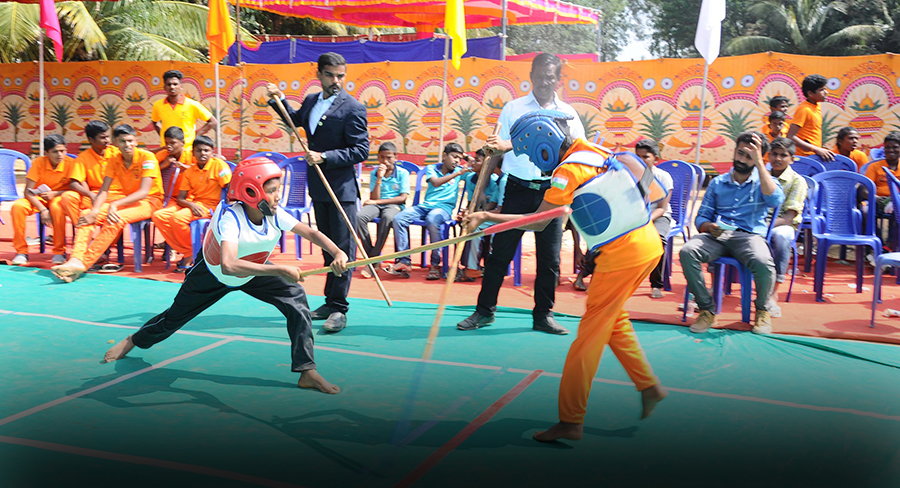
Learning Silambam
( சிலம்பம் பயிற்சி )
Beginners are taught footwork ( kaaladi ) which they must master before learning spinning techniques and patterns, and methods to change the spins without stopping the motion of the stick. There are sixteen of them among which four are very important. Footwork patterns are the key aspects of silambam and kuttu varisai ( குத்துவரிசை ) ( empty hands form ). Traditionally, the masters first teach kaaladi for a long time before proceeding to kuttu varisai. Training in kuttu varisai allows the practitioner to get a feel of silambam stick movements using their bare hands, that is, fighters have a preliminary training with bare hands before going to the stick.
Gradually, fighters study footwork to move precisely in conjunction with the stick movements. The ultimate goal of the training is to defend against multiple armed opponents. In silambam as well as kuttu varisai ( குத்துவரிசை ), kaaladi is the key in deriving power for the blows. It teaches how to advance and retreat, to get in range of the opponent without lowering one's defence, aids in hitting and blocking, and it strengthens the body immensely enabling the person to receive non-lethal blows and still continue the battle. The whole body is used to create power.
The usual stance includes holding the staff at one end, right hand close to the back, left hand about 40 centimetres (16 inches) away. This position allows a wide array of stick and body movements, including complex attacks and blocks. As with some northern Chinese systems, the silambam staff is said to have "one head", meaning that only one end is primarily used for attacking. When the student reaches the final stage, the staff gets sharpened at one end. In real combat the tips may be poisoned. The ultimate goal of the training is to defend against multiple armed opponents.
Silambam prefers the hammer grip with main hand facing down behind the weak hand which faces up. The strong hand grips the stick about a distance hand's width and thumb's length from the end of the stick and the weak hand is a thumb's length away from the strong hand. The weak hand only touches the stick and to guide its movement. Silambam stresses ambidexterity and besides the preferred hammer grip there are other ways of gripping the staff. Because of the way the stick is held and its relatively thin diameter, blows to the groin are very frequent and difficult to block. Besides the hammer grip, silambam uses the poker grip and ice pick grip as well. Some blocks and hits are performed using the poker grip. The ice pick grip is used in single hand attacks. The staff is held like a walking stick and just hand gets inverted using the wrist.
In battle, a fighter holds the stick in front of their body stretching the arms three quarters full. From there, they can initiate all attacks with only a movement of the wrist. In fact, most silambam moves are derived from wrist movement, making it a key component of the style. The blow gets speed from the wrist and power from the body through footwork ( kaaladi ). Since the stick is held in front, strikes are telegraphic, that is, the fighter does not hide their intentions from the opponent. They attack with sheer speed, overwhelming the adversary with a continuous non-stop rain of blows. In silambam, one blow leads to and aids another. Bluffs may also be used by disguising one attack as another.
In addition to the strikes, silambam also has a variety of locks called poottu. A fighter must always be careful while wielding the stick or they will be grappled and lose the fight. Locks can be used to disable the enemy or simply capture their weapon. Techniques called thirappu are used to counter the locks but these must be executed before being caught in a lock. Silambam also has many different types of avoiding an attack like blocking, parrying, enduring, rotary parrying, hammering ( with the stick ), kolluvuthal ( attacking and blocking simultaneously ) and evasive moves such as sitting or kneeling, moving out, jumping high, etc.
Against multiple attackers, silambam exponents do not hold out their sticks as they do in single combat. Instead they assume one of the numerous animal stances which makes it difficult for opponents to predict the next attack.
An expert silambam stylist will be familiar with varma adi ( Tamil: வர்மக்கலை / Telugu : మర్మయుద్దకళ ) ( pressure-point fighting ) and knows where to strike anywhere in the body to produce fatal or crippling effects by the least use of power. In one-on-one combat an expert would just slide his stick to opponents wrist many times during combat. The opponent may not notice this in the heat of battle until they feel a sudden pain in the wrist and throw the stick automatically without knowing what hit them. When two experts match against each other one may challenge the other that he will hit his big toe. Hitting the big toe can produce crippling effects on the fighter, making them abandon the fight. This is called solli adithal which means "challenging and successfully hitting".

Call / WhatsApp : +91 9994115849
Email : [email protected]
Date: 17 November 2023
Location: Tamil Nadu, India

